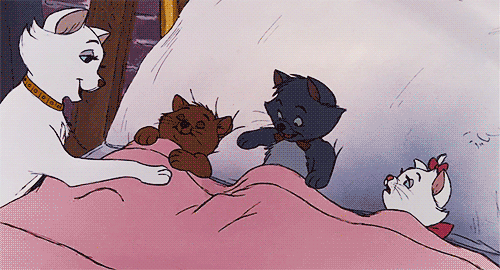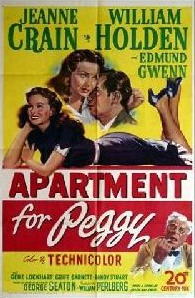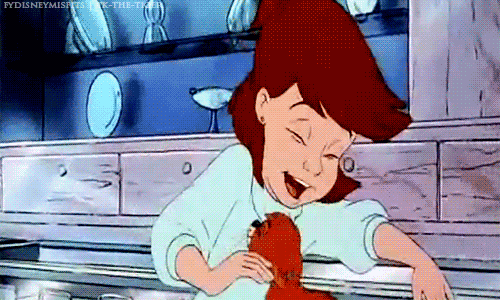

The AristoCats is an interesting animal (intentional pun), because, on the one hand, its story is deliberately lifted from past Disney features; but, on the other, it’s more adult and original than anything I’ve seen from them since the fairy-tale era. In watching something like 101 Dalmatians – of which this borrows from – you never really felt these were human characters shrunk into animals. Sure, Pongo and Perdita‘s problems have been faced by humans; but you never believed Pongo and Perdita, themselves, were human. Here, O’Malley, Duchess, and all the other characters, could have been human and simply transformed into animals. The AristoCats is Disney pushing the boundaries of what children enjoy, but includes things they hopefully won’t notice. It’d been a long time since I saw this, but I believe The AristoCats is more enjoyable for adults than children; and I recommend adults give it a second chance.
Duchess (voiced by Eva Gabor) and her three kittens have lived the pampered life with the wealthy Adelaide Bonfamille. One day, Adelaide tells her attorney that her cats will inherit everything at her death, much to the chagrin of her butler, Edgar. Edgar, soon, hatches a plot to get rid of the cats and collect the money for himself. Unfortunately, nothing goes according to plan and the cats are stuck on their own. Streetwise alley cat, Thomas O’Malley (voiced by Phil Harris), soon discovers the family and plans to get them home safely.

Let’s orient ourselves for a second. The 1970s were a shaky time for the Walt Disney company, in general. The AristoCats was the first film to be released after Walt’s death, as well as being the last film approved by him, personally. The company was also working towards an opening date for Walt Disney World in Florida, which was a huge financial risk for them. Thankfully, on a four million dollar budget, The AristoCats took in $55 million and was considered a success. It should have been considering the amazing talent assembled for it. The cast of people assembled here would go onto stay with the Disney company through several other movies, and/or were huge stars to get for a children’s film. In the acting category, you have Phil Harris playing our lead, O’Malley; Harris was Baloo in last week’s The Jungle Book. There’s also Eva Gabor as Duchess. Gabor was famous for Green Acres at the time, but she’d be well-known to children as the voice of Ms. Bianca in The Rescuers series, which we’ll get to in three weeks. You also have Disney repertory voice actor Sterling Holloway as the hilarious Roquefort, and Scatman Crothers as Scat Cat! Of course, Thurl Ravenscroft is a voice here, and if you don’t know who he is, then you better be looking him up. I also adored the voice of Pat Buttram as the voice of the dog Napoleon. I recognized Buttram’s voice immediately from an episode of Rugrats! The music, written by the Sherman Brothers, was arranged by the legendary George Burns; and Maurice Chevalier came out of retirement to sing the title song! Whew, that’s a lot of huge stars to pepper a movie with; and yet, none of them overpower each other.
The actual plot of the movie isn’t particularly original, and the movie really takes its time before establishing where it wants to break out of the shell. The concept of kidnapped pets immediately reminds you of 101 Dalmatians, and the “country cat/city cat” story invokes images of Lady and the Tramp. The AristoCats borrows those elements, but infuses them to create something more original and adult. The humans are incidental – as they were in Lady and the Tramp – and are actually colder and two-dimensionally crafted in comparison to the animals. The animals are the well-rounded characters in a way that the previous two Disney animal films weren’t. I mentioned it already in my intro, but the characters and situations feel more akin to human problems than animal ones. O’Malley is a bachelor playboy who wants to help out a beautiful woman, only to discover she has baggage in the form of three children. The kittens’ hope that O’Malley will become their father in a typical “setting up mom” story. Even peripheral characters like the geese twins and their drunken uncle Waldo (voiced by Bill Thompson) can be seen as full-fledged human caricatures. For the most part, the movie never treats these characters like “animals in danger,” but “people in danger.” I say “for the most part” because there are a few scenes in the beginning of the movie where the camera cuts to the faces of Duchess and the kittens in peril and their mutual looks of anguish. Typical of Disney, the lone little girl Marie is the one constantly falling off things and needing to be rescued (she’s also the one constantly spouting that O’Malley’s lines are “so romantic).

When Duchess and O’Malley meet, the plot becomes a typical road-trip romance; however, it feels different from the standard “I’m a pompous rich girl and I’m beneath the poor man.” Duchess never takes on airs, despite living in luxury. O’Malley is the one telling Duchess it won’t work because he’s poor, whereas Duchess fears it won’t work because she believes Adelaide won’t want another cat. I found that refreshing, not having a typical rich bitch (in this case, cat). The scenes between Duchess and O’Malley are oddly sexual. I had to chuckle as I wrote down “cat seduction,” but you really see these two characters flirting and engaging in serious seduction techniques on par with humans. Harris sounds like he’s channeling Robert Mitchum, with a vocal technique that inserts a lot of “baby’s” to his lines. He grows to love Duchess and her children, in a way that doesn’t feel like he’s obligated because she’s in danger. (You know how I feel about relationships blooming amongst disaster.) Other adult moments come across in the script. Uncle Waldo is a goose who’s literally about to be cooked, but feels he shouldn’t have been basted in white wine; “Being British, I’d have preferred sherry!” Also, there’s a hilarious dialogue exchange about “swinging” that made me think of The Princess Bride: “I do not think that word means, what you think it means.” I found myself praising the script several times. It’s easily one of the wittier Disney efforts I’ve seen in the last month or so. There’s fun character lines such as Duchess telling O’Malley “Your name seems to cover all of Europe;” and, most hilariously, Roquefort saying “He got me” after getting “shot” in the gut with a cork.
The movie isn’t flawless, and what is flawed feels like it shouldn’t be. The script and characters are so well done, that what you notice as being bad feels like things they could have easily been fixed or explained away. There’s no storybook opening to this, but simply uncolored scenes from the movie over a pastel background. For some reason, Marie is the only one of the children with a British accent; whereas, Berlioz and Toulouse have the Frenchiest names and the most American of accents. Furthermore, for a film set in Paris, there’s a duo of country bumpkin hounddogs and British geese. Other less than developed plot points include the tired device of having characters “dream” what we’ve just seen, and Roquefort saving the day by going to find Scat Cat, only we’re never sure how he knew where the alley cats were. I did find fault with why lengthy lines of dialogue had to rhyme. I’m not sure if the source material (IMDB lists it’s based on a story) had rhyming, but it’s a device that’s not used throughout, so when it does happen it feels weird and stilted; not natural at all. I also didn’t understand why Edgar actually goes back to the country hounds in order to get his bowler hat, and the basket that carried the cats. Was it because we needed to see the hounds again? Or because Edgar needed a purpose? It’s the one moment that screamed “padding!” Oh, and we get another lovely Asian stereotype involving Siamese cats.

In terms of music, the song, The AristoCats, sung by Chevalier is probably the weakest of the songs assembled. The rest of the songs are a blend of genres, highlighting both Duchess’ and O’Malley’s worlds; her’s being classical and his being jazz. I sang “Scales and Arpeggios” for a choir concert and it’s still a fun song with a lyrical tongue-twister for lyrics. ”Everybody Wants to Be a Cat” is the defining song for this movie (sorry Maurice) and is a jazzy cacophony of delight. I also found myself singing O’Malley’s theme song that includes his full name. (“Abraham De Lacy Giuseppe Casey Thomas O’Malley. O’Malley, the alley cat.”) The songs are consistently good, the animation less so. I mentioned that the xerography process had been significantly refined in The Jungle Book. I’m not sure what went wrong here. The characters are notably darker – with thicker lines – than the backgrounds, and seem to walk in a constant state of rear projection. It’s not nearly as noticeable when the animals are around. In fact, the animals look beautiful, particularly in HD. The humans are that scratchy, unfinished style that they were in 101 Dalmatians, and feel so jerky that it’s like they’re not finished.
I will say, for the flaws I mentioned, they didn’t do a lot to lessen the impact. The AristoCats was surprising to watch because I never liked it before; now, I’m aware of how well-shaped it is. The characters are human and feel as such. I loved Duchess and O’Malley, but they didn’t stand a chance compared to Roquefort. I think this is Sterling Holloway’s best work, so far. Roquefort is dressed like Sherlock Holmes (which we’ll see later on in The Great Mouse Detective), and is just hilarious because he’s so tiny; everything he does is wrong, but lovable. I might actually go buy this on DVD; not because it’s perfect, but because it’s great in a long line of so-so.
Ronnie Rating:
NEXT WEEK: I’ve been dreading this one; Robin Hood.
Interested in purchasing today’s film? If you use the handy link below a small portion will be donated to this site! Thanks!
Rent It
Buy It on DVD
The Aristocats (Special Edition)
Buy It on Blu-Ray
The Aristocats (Two-Disc Blu-ray/DVD Special Edition in Blu-ray Packaging)
Filed under: 1970s, Adventure, Animation, British, Comedy, Family, Journeys in the Disney Vault, Musical
















































































































































